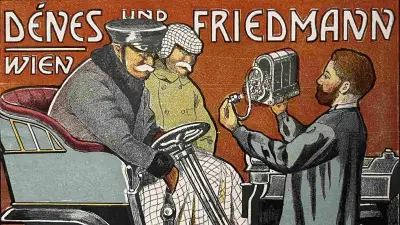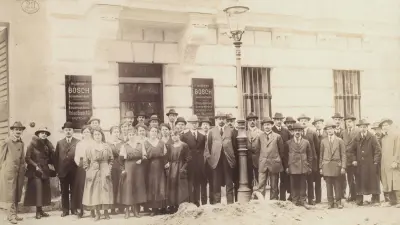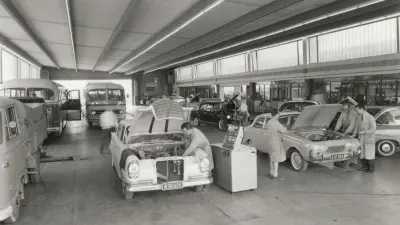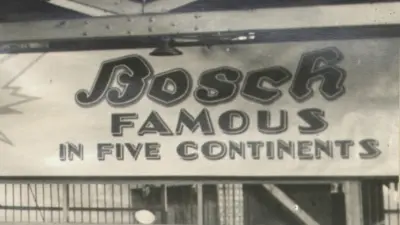125 years of Bosch in Austria and Hungary
Close ties

Austria and Hungary were streets ahead. Despite only just having been unveiled at the Berlin Motor Show in 1899, Robert Bosch’s innovative, reliable vehicle ignition system was already available in Austria-Hungary. Successful regional companies specializing in the sale and manufacture of Bosch products in Europe established themselves in the two countries.
The new office building in Vienna, the Haus an der Brigitta-Brücke, was adorned in celebratory decorations. The mild weather on May 3, 1924 put 120 expectant guests in a cheerful mood. Robert Bosch had traveled all the way from Stuttgart with two of his directors and emphasized the emblematic nature of the building in his opening address. The building was constructed in spite of the many difficulties arising after the first world war, and was to serve as a symbol of economic cooperation between Austria and Germany.

The Hungarian engineer and businessman Eduard Dénes had been selling Bosch products in Austria and Hungary since 1899. Just under two years earlier, Bosch had created the first reliable ignition system for a vehicle with the magneto ignition device, causing a stir in the automotive world. Although demand was strong in Germany, Bosch realized that the German market would not be sufficient for the continued existence of his company: Dénes, who was the sole representative for the Austro-Hungarian Empire, found a partner and renamed the company Dénes & Friedmann in the same year. As early as 1905, a catalog of Dénes & Friedmann — by then an established name in the sale of automotive accessories — was also advertising Bosch’s ignition devices. The new century got off to a promising start. Bosch’s expansion and success in Austria and Hungary seemed unstoppable.

However, the outbreak of the first world war presented Bosch with new challenges, including in relation to Austria-Hungary. The Austrian ministry of war repeatedly called on Bosch to move its manufacturing operations to Austria. Despite the economic pressure, Bosch resisted the demands and instead decided to take the distribution of its products into his own hands from 1917. He took the first steps in this direction at the end of the year, and founded his own Bosch companies in Vienna and Budapest the following year. Irrespective of the troublesome economic situation, Bosch opened its own sales office in Vienna with a branch in Budapest in 1918.
With the economic upswing that followed in the years after the war, a phase of new building activity began. In Vienna, a modern sales and administration building was built and officially opened in 1924. Its austere architecture, which dispensed with decorative elements true to the principle of form following function, also made a name for itself outside Vienna.
A few years later, associates in Budapest also moved to a modern, newly built sales office and at the same time gained complete independence from the Vienna corporate headquarters.


Both the growth during these interwar years and Bosch’s presence in Austria came to an abrupt end with the advent of another world war. After the end of the second world war, the company in Vienna was placed under Austrian administration, and it was not until 1950 that Elektro-Diesel Handelsgesellschaft resumed sales of Bosch products. Over subsequent decades, the company continued to develop, undergoing several transformations culminating in the founding of Robert Bosch AG Wien in 1982. In Hungary, however, all of Bosch’s assets were confiscated by the Soviet authorities as spoils of war and eventually expropriated. For decades, the Hungarian market was only able to be supplied via Vienna. It was not until the fall of the Iron Curtain that Bosch became active in the country again, with the founding of the Hungarian Bosch company in Budapest in 1991.
The history of Bosch in Austria and Hungary is a story of challenges and, ultimately, success. Successful regional companies with their own manufacturing facilities have long since been established in both countries. They are key locations for Bosch and are deeply rooted in the industrial and cultural landscape of the region.
The partnership that began so early on proved to be long-lasting and fruitful: a testament to the skill and foresight of Robert Bosch and his partners.
Author: Angelika Merkle



